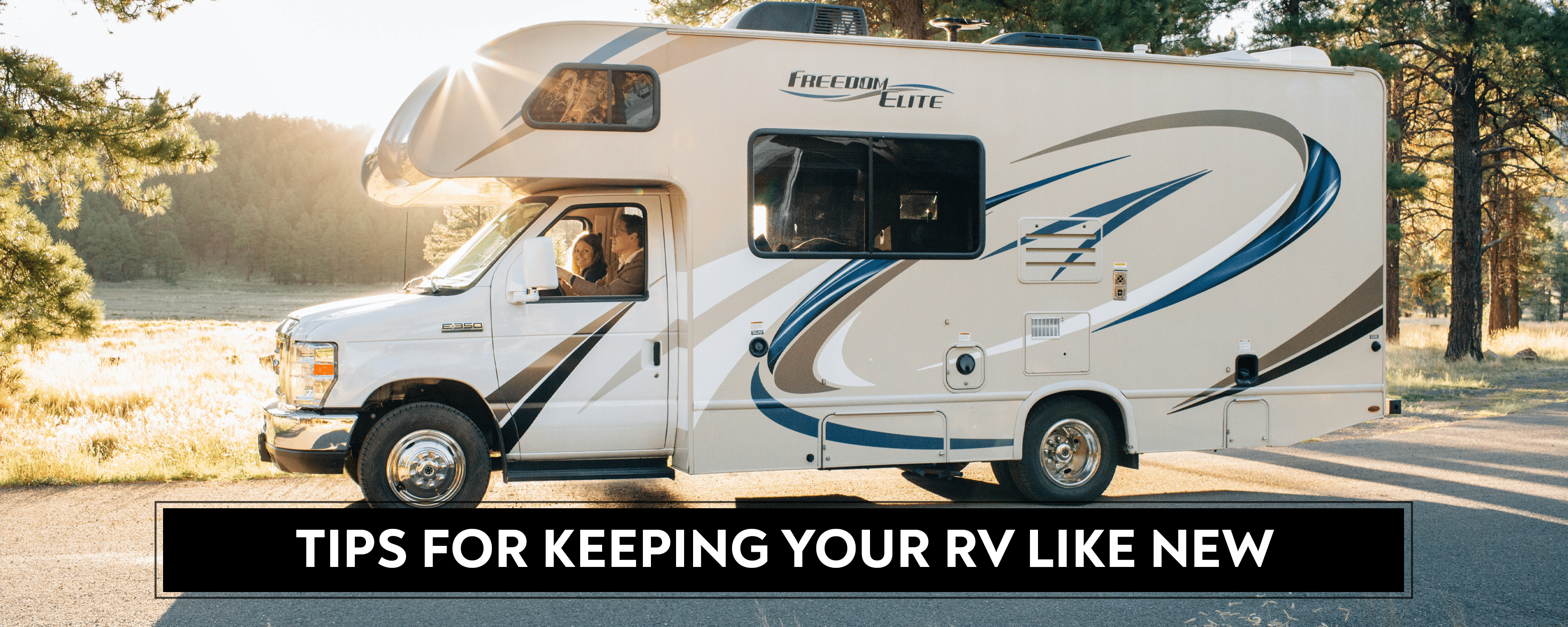
FREE US SHIPPING ON ORDERS $75+ (LOWER 48 STATES)
FREE DETAILING ADVICE +1-877-838-2672


RVs are big vehicles and prone to getting dirty especially after a long trip. Commonly, RV owners find themselves constantly battling the issue of cleaning and keeping their RV clean along with protecting it from the harsh elements that RVs encounter out on the nearly endless roads of America. Here, we will explore the top tips for keeping your RV exterior clean and protected so you can ultimately save precious time in cleaning such a large vehicle by protecting it the right way.
Your RV is a major investment just like any other large purchase. Protecting that investment involves a little preventative care and most of that starts with cleaning and protecting your RV’s exterior with products like TopCoat® PolyWash®, TopCoat® F11®, and TopCoat® F11PRO®.
RVs are constantly exposed to harsh elements and having such large surfaces on the outside puts them at greater risk for damage from dust, dirt, road debris, bugs, bird droppings, rain, snow, sun RV rays, and other harsh environments that mother nature dish out.
Wash your RV the right way
Washing your RV is one thing but protecting it after the fact is another. First, you’ll want to be sure that you wash your RV thoroughly to get all the grime and dirt that may rest on its massive exterior surfaces. You can do this using a product like TopCoat® PolyWash®. Washing can sometimes be thought of as a simple task that just requires soap and water. However, you’ll want to be assured that you use the right product to avoid causing damage and to ultimately get the job done to remove all containments from the exterior surfaces.
Pick the right cleaners
There are countless cleaning products on the market for vehicles and ones that claim to be designed to clean RVs. You’ll want to look for cleaning products that work well on fiberglass surfaces and avoid ones that contain petroleum solvents, citric-based acids, or harsh abrasives. Most RVs utilize several different exterior materials, including fiberglass, rubber, and often use vinyl roofs and graphics, and vulnerable painted surfaces. There are many water-based and environmentally friendly cleaners that do a wonderful job of cleaning RVs without the risk of causing damage to any of the vulnerable surfaces or materials on the exterior of your RV. TopCoat® PolyWash® is an Eco safe water-based formula with no solvents or abrasives that can be used to wash your RV without concern of causing damage.
Use the right tools and avoid easy mistakes
Because RVs are huge and most of the surfaces that require cleaning cannot be reached by hand, it is best to use the proper tools, which include brushes attached to extended poles, microfiber brushes and towels, and a high-pressure sprayer (or pressure washer with a wide nozzle) to get those hard-to-reach places. Thoroughly rinsing and light-pressure-washing your RV to get loose dirt, debris, grime, or bugs off is essential before you wash it with your soapy brush or microfiber towels using TopCoat® PolyWash® and TopCoat® Professional Detail Microfiber Towels or the innovative TopCoat® LuvGluv® for those hard-to-reach crevasas. It is best to use a two-bucket wash method to avoid scratching the RV surfaces with a containment brush or microfiber towel. Use of an extended hose or pressure washer will help remove any soap residue from the roof, so it does not sit and dry. When drying your RV, be sure that the roof and large surfaces are dried as well to avoid water spots that cannot be seen but could later cause damage to vinyl graphics.
Protect your RV’s exterior with a sealant
Just like protecting the paint on your car, an RV demands protection for its large surface areas that are subject to the harsh elements of the outdoors.
Let’s face it, waxing your RV by hand is probably out of the question as it could literally take days to get the job done considering how large an RV is. Instead, the use of a sealant spray that goes on easily and can be quickly buffed in is ideal. A water-based sealant like TopCoat® F11® may be best as it does not contain any petroleum solvents or harsh abrasives that are subject to damaging fiberglass or vinyl graphics found on most RVs. TopCoat® F11® and TopCoat® F11PRO® are proven sealants that can go on any surface of your RV.
Paying special attention to the crevasses of RVs is essential to keeping it protected to prolong the life of your RV and reduce the rate of replacing items like window and door rubber seals, the seals on cargo areas, vinyl linings, and even those vulnerable plastic surfaces. You will want to use a protectant or sealant like TopCoat® F11® that doesn’t just clean, but also moisturizes the rubber seals so they will last longer and not dry up in dry areas of America like the north, west, or southwest. Many of the rubber seals and crevasses often attract dust and dirt that you cannot see until they cause damage.
While applying a sealant like TopCoat® F11® or TopCoat® F11PRO® to your RV may seem like a time-consuming task, doing so will extend the life of your RV and save you time and effort for the next time you clean because many sealants are hydrophobic and will prevent surfaces from getting dirty so fast by repelling water.
For the best protection in a sealant, you may use a ceramic coating like TopCoat® Crystaleen® to coat the exterior of your RV for protection that lasts several years. You will want to find a ceramic coating that has a 7H hardness and lasts 5-plus years for the best durability, which can be found in TopCoat® Crystaleen®.
Bonus Tip: After protecting your RV with a sealant that is hydrophobic like TopCoat® F11®, pay special attention to the water beading. Once the water stops beading, it may be time to reapply your sealant, which should be months after the last application. If you apply TopCoat® F11PRO®, the protective properties and hydrophobicity will last 12+ months. With a ceramic coating like TopCoat® Crystaleen® you may go several years before re-applying or adding a new sealant.

We want you to be 100% satisfied with everything you buy from TopCoat. And if you’re not entirely happy with your purchase we will refund your money in full, or exchange the goods. All we ask is that you contact our customer services and then return the products back to us.